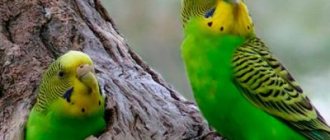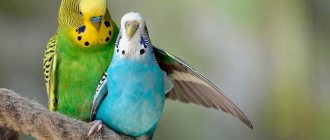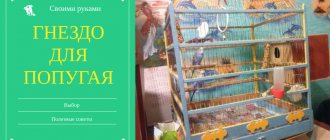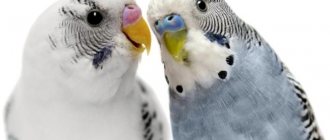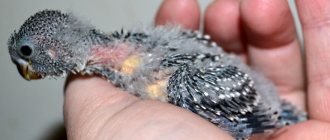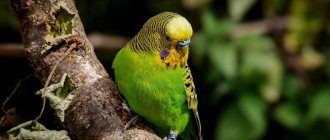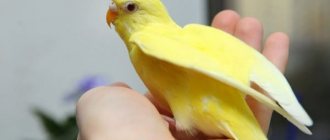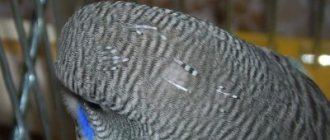In the category of feathered pets, budgerigars occupy the leading positions in the popularity ranking. Beautiful, cheerful birds provide their owners with many positive emotions. Every owner understands that in order for a pet to be healthy, a proper diet is required. But a balanced diet is not enough for a complete supply of vitamins and minerals necessary for life. It is necessary to include special supplements in the poultry menu to prevent the formation of a deficiency. They are especially important in winter, when the amount of vitamins and minerals in foods is reduced.
The need for vitamin and mineral supplements
Inclusion of vitamin and mineral supplements in the diet of a budgerigar:
- Will create good conditions for normal development and growth. A complete supply of minerals and vitamins allows the bird to feel great, remain active, and ensure the correct passage of metabolic processes.
- It will prevent the occurrence of diseases, strengthen the immune system, reduce the risk of stress and other negative factors.
- Eliminates the deficiency of nutrients in the body, leading to the appearance of diseases.
Feeding your pets is necessary not only in winter. They need an additional supply of minerals and vitamins during the period of molting, recovery from illness, and while hatching eggs.
Too frequent shedding: possible reasons
If your pet updates its outfit too often, this is a serious reason to pay attention to its health. Some alarming reasons for increased molting include:
- illness or severely weakened immune system.
In this case, molting occurs more often than usual or is prolonged too much: feathers fall out in small quantities, but almost constantly. If, in addition, the parrot has become lethargic and has lost its appetite, it is worth taking it to a specialist and not delaying treatment. Another well-known disease that causes problems with feather change is French molt, in which young chicks lose feathers en masse, and new ones grow very slowly or with noticeable defects. The nature and methods of treating French molt have not yet been studied, although, according to some versions, the disease can be considered genetic; - poor nutrition.
Untimely loss of feathers in parrots is one of the signs of a lack of nutrients, vitamins and minerals. In this case, veterinarians advise reviewing the pet’s diet, and in particularly difficult situations, prescribe multivitamin solutions with a balanced content of vital substances; - stress.
Another serious negative factor affecting the frequency of molting is the psychological discomfort that the parrot experiences due to external shocks. This could be a move, the loss of an owner, the appearance of pets in the apartment, or a sudden change in weather. If it is possible to accurately determine that the bird began to molt earlier precisely because of stress, it is important to eliminate its cause if possible. In comfortable conditions, the pet will feel better, and the cyclical change of plumage will gradually improve. Even if, after observing your feathered pet, it was possible to establish the causes of unnatural molting, it is still worth showing it to a veterinarian, who will understand the diagnosis and prescribe the appropriate treatment.
Essential vitamins for a parrot
An effective positive effect will be ensured only by properly selected fertilizing. Owners need to know what vitamins their birds require for health and normal development. There are grain and liquid products for feeding on sale. The grain product does not allow you to accurately determine whether the parrot has eaten the required amount of vitamins. Therefore, experts recommend using liquid fertilizers.
- Vitamin A is necessary at the stage of growth and development. Adult birds also need it to strengthen the immune and nervous systems. Retinol deficiency will lead to breathing complications and digestive diseases.
- The quality of intestinal functioning, as well as the pet’s appetite, directly depends on vitamin B1. With its deficiency, activity decreases, interest in food disappears, convulsions and paralysis of the paws may occur.
- Vitamin B2 also performs important functions. It is necessary for the normal functioning of the reproductive system, so it is especially important for birds living in pairs. Deficiency of this element causes anemia and exhaustion.
- Vitamin D is responsible for the condition of the musculoskeletal system. If there is not enough of it in the bird’s body, lethargy, apathy, and lack of activity are observed. It is imperative to introduce it into the diet during egg laying. A deficiency of the element will affect the hardness of the shell.
- Ascorbic acid performs many significant functions. With its deficiency, growth and development are inhibited, immunity is weakened, and the structure of bone tissue is disrupted. If birds have the right diet, vitamin C deficiency usually does not occur, since it is synthesized in the body.
- The main element for the reproductive system of a parrot is vitamin E. Its deficiency will lead to dysfunction in this area. A pair of pets living together needs this feeding.
The story of the cockatoo
Several years ago, I spoke on the phone with a woman who was planning to temporarily foster her cockatoo with us. While gathering information about her bird, I asked what her cockatoo usually eats. “Everyone,” this woman answered me. Confident that I understood correctly what was meant by this, I moved on to the next questions. Such as: does she cover the cage at night or not, etc.
A week later the bird arrived to stay with us for 10 days. During this time, I offered her vegetables, whatever I could think of. I cut them into cubes, put them through a vegetable cutter, and pureed them. I also cut them into slices and shavings. I steamed them, stewed them, baked them, and also offered them raw. But none of this worked. During the entire 10 days that the cockatoo was with us, he ate nothing but seed mixtures.
When the client came to pick up her bird, I told her that her parakeet refused to eat vegetables. She looked at me in surprise.
Essential minerals for a healthy diet
Minerals are no less important for the health and development of a budgie than vitamins. The main nutrition that ensures their supply is the shell of the cuttlefish. The product is sold in the form of sand. When purchasing fertilizer, you should make sure that it contains all the necessary minerals:
- Iodine, which ensures the normal functioning of the thyroid glands.
- Calcium, involved in the formation of bone tissue, ensuring proper growth and development.
- Phosphorus and magnesium, which support the musculoskeletal system in good condition.
- Sulfur, which provides the required strength of claws, beaks, and feathers. Feeding is especially important during the period of molting and feeding chicks.
- Potassium, necessary for normal muscle function and cardiac activity.
- Iron and copper involved in hematopoietic processes.
Pet stores have special vitamin and mineral complexes in the form of liquids. They contain all the necessary elements.
Verbal misunderstanding
“But he doesn’t eat vegetables!” she told me, sincerely perplexed that such a thing could even occur to me. And it was then that an epiphany descended on me: this bright moment of truth. The misunderstanding was caused by different understandings of the word “ALL”. When a woman said that a parrot eats “everything,” she meant that the pet eats everything her family eats. And she even looked a little embarrassed as she explained to me that her family doesn't eat vegetables. And that her parrot is very cute eating meat and potatoes, pasta and pizza, potato chips, etc.
Vitamins and minerals in feed
It is not necessary to constantly include feeding in the bird's diet if it is eating properly. A large number of essential minerals are found in nuts and seeds. The champions in terms of the amount of useful minerals are hazelnuts and walnuts, and pumpkin seeds.
From time to time you need to give your parrot sprouted grains containing useful substances in maximum concentration. You should prepare porridge from beans, peas, and lentils for your pet. Fruits and vegetables, which are natural storehouses of minerals and vitamins, should become a permanent component of a budgie’s menu. The diet includes both products grown in our climatic conditions and exotic ones. You can give your pets: tomatoes, cucumbers, pears, apples, as well as pineapples, bananas and kiwis. Excellent suppliers of essential macro- and microelements are beets, spinach, white cabbage and broccoli.
Budgerigars need twig food. Branches of cherry, birch, apple, and currant will supply the body with minerals and fiber, which ensure the normal functioning of the digestive system. In addition, you should periodically give the birds egg shells, which supply calcium and other minerals.
Normal (natural) molting: features of the process
The main reason for normal molting in parrots, regardless of their species, is the need to renew their feathers. Only intact and healthy plumage can help birds maintain normal heat exchange, feel comfortable in both heat and cold, as well as protect the skin from pathogens, and, of course, provide the ability to fly. This is why it is so important for a parrot to get rid of worn and broken feathers that do not provide safety and comfort.
First molt
The parrot undergoes its first, or so-called juvenile molt, at a very early age - most often 2-3 months after birth. The process of replacing the first down and soft, weak feathers is quite long - up to several months with short intervals, during which the change of plumage is suspended. After the change of down to feathers, the bird is capable of flight, and the complete renewal of the bird’s plumage means the end of puberty and maturation of the parrot.
Shedding in adulthood (periodic)
As birds mature, they still need to shed old feathers and grow new ones. However, the frequency and duration of molting may vary among different species of parrots. The following options can be considered normal:
- Once a year (large parrots);
- 2 times a year (medium and small types);
- every few months (budgies).
The molting process can take from two weeks to several months. At the same time, the plumage is renewed gradually and little by little, so that the change in the parrot’s outfit can only be noticed by the number of fallen feathers and fluff, some ruffled plumage and the presence of stumps of new growing feathers. The parrot may scratch itself, feel chilly, and become irritable. But if the feathers fall out in clumps, or bald patches begin to appear and grow on the bird’s body, you need to contact a veterinarian as soon as possible.
Back to the question of vegetables and fruits
So, let's return again to the question of vegetables and fruits for parrots. The problem with fruit is that it is often too nutritionally poor. But at the same time, parrots love to eat them more. On the other hand, vegetables are much richer in nutritional properties than fruits. At the same time, parrots (like people: both old and young) like to eat them in much smaller quantities. I think there is a clear pattern here (perhaps this is one of Murphy’s laws): what is nutritious for you is not tasty.
Official Statement #1
I'll do it before you all start screaming in outrage. Although I can already hear you seething with emotions. I officially declare that I am fully aware of the fact that any numbers in the answers will be based only on your assumptions. We all know that it is virtually impossible to tell what a parrot throws away and what it actually eats.
But you don’t need to take into account everything that the parrot scatters around the room, and even manages to drive it under your Empire style table. Where you will later find it in an unrecognizable plum color. The purpose of my survey is not to drive people crazy. Parrots already drive them crazy (thank you, I already know that). The purpose of the survey is to get customers to think about what their parrots are actually eating from what the owner puts in their feeders. Obviously these are two different things.
Forced clarification
Then I realized that I needed to ask clients a little differently about what they feed their parrots. As a result, I settled on the following: First question: what is the basis of your bird’s diet? (for example, granulated food or seed mixture). The next question (which puzzled every client): If we take the entire diet of your bird as 100%, what will be the proportion of the following components in it:
- basic diet (seeds or granulated food),
- vegetables,
- fruits (considered separately from vegetables),
- protein products,
- others (here I left space to list what was meant by others).
Later, instead of “other”, I began to indicate “carbohydrates” (pasta, bread, etc.) and snack foods (cookies, potato chips, ice cream, etc.).
How much should a parrot eat?
We parrot lovers usually make a huge mistake when feeding our birds. We believe that the bird eats as much as it needs. Instead of going by its actual size. I don’t know about you guys, but Sam, my blue and yellow macaw, lives with me. He is over 40 years old. And he thinks that he is bigger than the 36 kilogram Doberman who also lives with me. And my friend has a parrot named Cyclone, who thinks that he is bigger than a Great Dane. Yes, yes, just ask him.
In matters of psychology, you can rely on what the parrot thinks about itself. But when it comes to feeding, the approach should be different. The fact is that we all overfeed our parrots. This is not a problem until we start feeding the parrot what he especially likes. For example, pasta. Then he no longer eats what is good for him. For example, dandelion or cabbage. As I already wrote, it so happens that I like vegetables. But if I were asked to choose between vegetables and chocolate cake...
Once, a client brought me a Gray coat along with the following set of products: a large container of seed mixture, a box of Fig Newtons cookies and a jar of cherries candied in liqueur (and this also amazed me!). When I asked her a question, she explained that they give the bird a cherry every time before leaving for work and a cookie before bed. When I clearly expressed my concern, she told me this. “But it’s just one cookie and a cherry - it’s so little.”
Comments on the above components
Now let me go into more detail about each of the components of the diet separately. The very concept of the main diet usually does not require explanation: it is either granular food or a seed mixture. But as for the other components, I never cease to be amazed at how many people find it difficult to answer them. I wonder if they don't take any more nutrition classes in school? Or have I become too demanding over the years?
For example, many people don’t even see the difference between vegetables and fruits. They are accustomed to using these words in conjunction and it is already difficult for them to separate one from the other. When I ask what vegetables your parrot eats, in many cases the answer is apples and grapes. People don't even think about what they call fruit. However, this separation is necessary, since there is often a stunning difference in nutritional value between them (more on this below).
Table from a book on feeding reptiles - fact vs. fiction
Well-known reptile veterinarian Frederic Frye provided very interesting data in a nutritional table in his book Iguanas: A Guide To Their Biology And Captive Care, 1993. These data represent a real sensation in regarding a number of products. However, most of them are based on publications of the US Department of Agriculture. See Composition of Foods, Volume 8. This chart literally opened my eyes to what actually has nutritional value and what I thought it did. This table provides data on the content of certain vitamins - A, B1, B2 and C. As well as minerals such as calcium, phosphorus and iron. Plus data on the protein content in each of the widespread fruits and vegetables.
People, let me tell you, this data amazed me. For example, the same apples that, according to the saying, “keep the doctor away,” are actually very primitive in their nutritional properties. Just sweet water and a little fiber. There were many foods that I believed contained many valuable nutrients. However, as it turned out, they were not particularly valuable. For example, products: oranges, grapes, pears and grapefruit. I always felt so self-important when I ate grapefruit! Bananas, one of parrots' favorite foods, contain 3.5 times more phosphorus than calcium. This means that the owner must feed the bird, and the bird must eat, 5-7 times more calcium-containing foods to maintain optimal calcium-phosphorus balance.
Grapes are also a problem. The body is that it contains twice as much phosphorus as calcium. Three halves of yellow peaches contained a good dose of vitamin A (1000 IU (international units)), but white peaches contained only one tenth of this amount, i.e. 100 IU. But they are considered fruits of equal nutritional value. It's funny, isn't it? Keep this in mind when thinking about how to properly feed your parrots. It is also interesting that the white peach was an achievement for breeders. But by removing the color, they also removed its nutritional value. And this is also called a “step forward”! People are so "reasonable" sometimes, aren't they?
